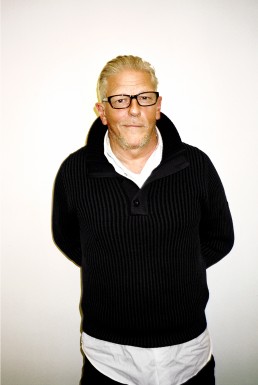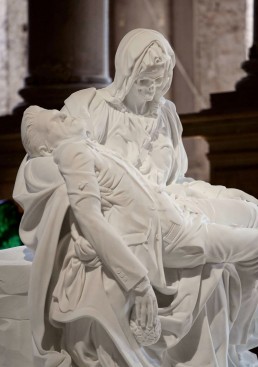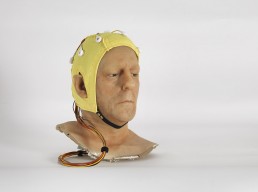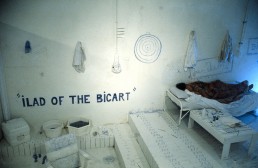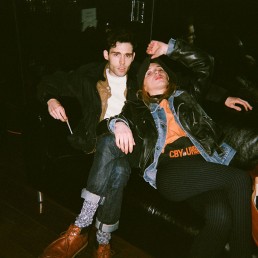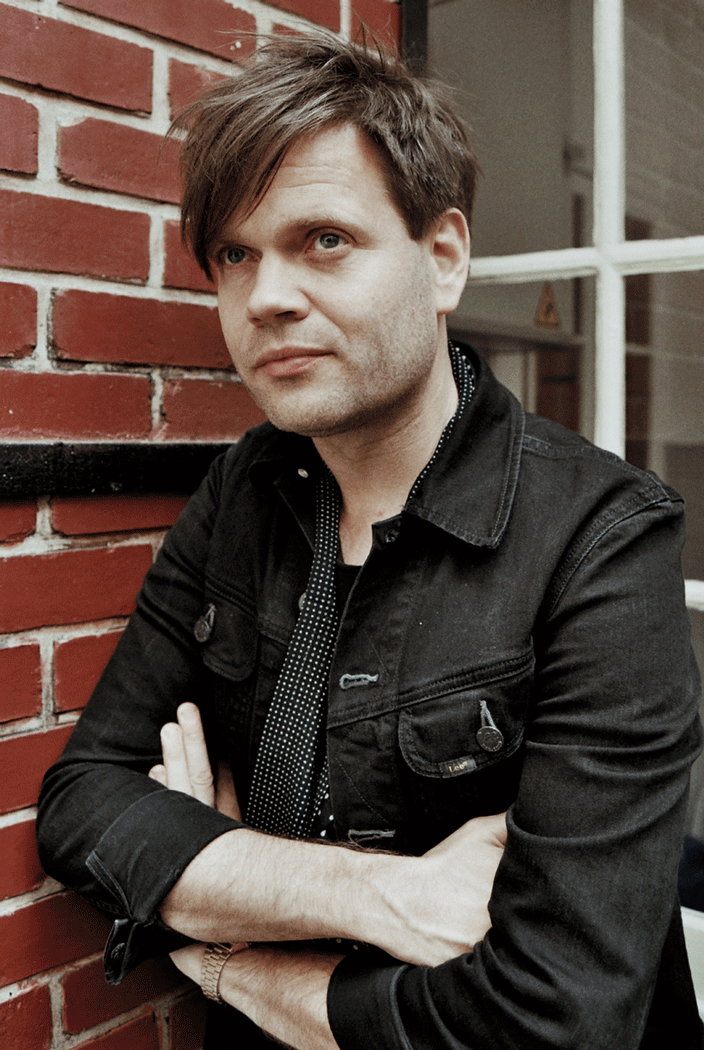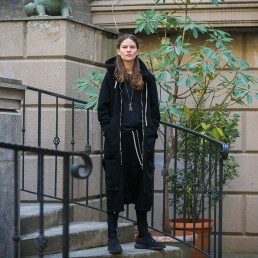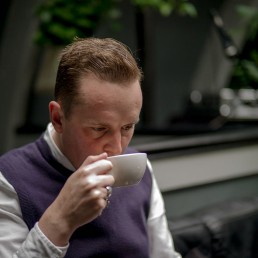Over the past thirty years, Belgian multidisciplinary artist Jan Fabre expands the horizons of every genre he applies his artistic vision dealing with such themes as lust, beauty, erotica and the body; alongside age-old rituals and philosophical questions. With works as diverse as his The Angel of Metamorphosis exhibition held at the Louvre Museum in 2008 and his decoration of the ceiling of the Royal Palace in Brussels Heaven of Delight (made out of one million six hundred thousand jewel-scarab wing cases), his works have been praised on wide eclectic spectrum. He is an artist that fights for daily reflections.
Jan, your creative activity can be found in both Angelos – representing you as a visual artist and Troubleyn – representing you as a theatre artist. I’m curious about the etymology of these words in the context of your art. Do they serve to distinguish two different creative personas?
Etymologically, the word Troubleyn – which is actually my mother’s family name – comes from old Flemish and it means stay faithful. Twenty-five years ago, I made an opera trilogy called The Minds of Helena Troubleyn and it was exactly at that moment that I decided to call my theatre company and my office Troubleyn. Troubleyn is a very special name in Belgium, there’s only like five of them and they are all my family. In the context of my work, Troubleyn is more like stay faithful to beauty and Angelos comes from the words angels and messengers, so my visual artworks are sent out like messengers of beauty.
That’s very interesting; I thought Troubleyn was more related to trouble, because your performances were very provocative and unusual, now I see it has a more personal meaning.
No, not at all, it’s my mother’s maiden name (laughs).
Jan, insects are one of the core components of your work, was this fascination inherited from one of the greatest entomologists in history, your great-grandfather Jean-Henri Fabre?
Yes, I must thank my family members for that. They had a lot of old publications, manuscripts, drawings. I remember the first time I saw them, I was 17 or 18 years old and it influenced me a lot. Later, I built my first laboratorium, The Nose/Noselaboratory (1978 – 1979), in my parent’s garden and I was sitting inside at a small table drawing, using my microscope, digging up worms, catching flies; ripping off wings of flies and trying them on the worms. I felt like Dr. Frankenstein doing these experiments.
Do you have any favourite insects?
I do. The Scarabaeus, it’s my favourite one.
One can find it in many of your sculptures.
Yes, because in many of these sculptures the Scarabaeus symbolizes the bridge between life and death, that symbolism is also present in traditional Flemish paintings.
Why is the Scarabaeus your favourite insect? For aesthetic reasons or something more personal?
Both, for ethical and aesthetic reasons. A significant part of my creations from the nineties are research about the exoskeleton and the endoskeleton. We humans have an inner skeletons, Scarabaeus have an outer skeleton. That’s the reason why this insect survived a couple of million years and of course thinking about exoskeleton is thinking about creating a new skin, a new armour for humans… creating a new kind of protection. From the moment humans have an outer skeleton, you can’t hurt them anymore, you can’t wound them and you go away from the stigmatas of Christ.
Going back to the antipodes of your career in the late 70s and early 80s, could you tell me more about the influence of those iconic performances, like Bic Art Room for example?
There’s a big exhibition touring in Europe curated by Germano Celant – also the inventor of Arte Povera – called Stigmata. Actions & Performances 1976 – 2013 about my solo performances from 1976 until now. The knowledge of the experience, the mental and physical experience of a solo performance influences my work very much. You can see this clearly in this exhibition.
I’m particularly thinking about the Bic Art Room performance when you isolated yourself during many days in the room. Was it a process of self-discovery? What were the reasons that led you into that experience?
There were different reasons, to be honest. I lived for three days and three nights in a white room, there was no difference between day and night. I wanted to go through a series of mental and physical experiments, but I also wanted to experiment with drawing, to feel what it is like to become kind of a drawing machine. I also wanted to explore the idea of being locked in a jail and out of boredom start drawing. Later came the pleasure and consequently more drawings. I started to draw on my body, on my clothes, on the white sheets, on the walls. In the end I was more like a drawing machine than an artist because I managed to stay awake during the whole performance and at some point, I started to act in a different way and became more lucid. It was all these questions about being human, being an artist, staying awake for many days, being locked in jail, those were the reasons I did the performance.
What was the first thing you did when you left the room?
I was a young guy in my twenties. When I came out I went to dance (laughs)!
That’s a nice thing to do after being released. One of your latest exhibitions, Sacrum Cerebrum celebrates the human brain, can you tell me more about it?
It’s a series of new works based on the motif of the holy heart. It’s kind of a research around artists and paintings from different countries representing Mary and Jesus Christ. In two words, the exhibition is basically a combination of science and religion; a consilience between visual art, science and religion. The scientific part was influenced by Giacomo Rizzolatti, a well known Italian neurophysiologist who discovered mirror neurons, with whom I made a performance film in 2013 called Do we feel with our brain and think with our heart? It’s because of mirror neurons that you know imitation, empathy and compassion; it’s all a construction of our brain. And we all know the brain is the sexiest part of the body. Without imagination, there’s no erection.
So basically, the idea was to take the sacred heart imagery and reinterpret it through science?
Yes, the idea was to reinterpret the sacred imagery and the religious elements through science. The exhibition has various drawings and collages, but also small brain models made from the purest Carrara white marble. I find them very erotic and sensual.
Have you ever been through a life-changing situation?
I think I had two moments in my life that were very important. Twice I was in coma and as an artist all my work is essentially about the post-mortem stage of life.
Can you tell more about the sculpture, The man who bears the cross that is now part of the patrimony of the Cathedral of Our Lady in Antwerp?
What happened was two years ago, I made this sculpture that was shown in Antwerp. A sculpture of myself balancing a huge cross on my hand and it was made of wax. Then the priest Bart Paepe came to the exhibition and decided to buy it. That sculpture was the base of the bronze sculpture The man who bears the cross which was recently inaugurated as a permanent artwork at the Cathedral of Our Lady in Antwerp and placed right in front of Ruben’s Descent of the Cross.
While observing your extensive oeuvre we can find a few homages to artists like Hieronymus Bosch, Joseph Beuys and even Michelangelo with your famous Pieta sculpture where Death instead of Mary carries your body. What is the purpose of these homages?
You have to understand that I’m a dwarf born in the country of giants. My father introduced me to Rubens when I was five. Seeing the genius of Rubens had a huge impact. Then I saw paintings of Hieronymus Bosch in a museum. Later van Eyck and van Dyck, the whole Flemish school was close-by, and these are my roots. These artists are so brilliant, so imaginative, very daring and subversive. When you see a Hieronymus Bosch painting or a van Eyck painting it’s incredibly much more imaginative and subversive than any contemporary art today. So I steal a lot from these artists, and when I do these homages, it’s a way to pay my respects to tradition.
I remember the famous busts you did in homage to famous French gangster Jacques Mesrine. What were the reasons back then?
It happened for different reasons, I was raised in the streets of Antwerp and I was a good street fighter, so I was always busy in the nightlife with gangsters. At some point back then I made a performance in New York called Art Kept Me Out Of Jail and that idea stayed with me, art and beauty saved me. I still have a lot of respect for gangsters and it was through befriending artists that I discovered Jacques Mesrine. I started to read his biography, all the books on the subject and for my exhibition at Louvre, L’ange de la metamorphose (2008) – I was the first living artist to stage a solo show there – they asked me to do a performance as well. I saw the Louvre as a jail, so the whole performance was about an artist who wants to escape from the museum; it was a reference to Mesrine because he was well-known for his brilliantly orchestrated escapes, using masks, beards and costumes, basically metamorphosing himself. Transformation and metamorphosis are very important topics in my work and these two elements were crucial for my solo performance which was also about the passion for love and for anarchy.
Some people describe you as a multimedia artist, how do you see yourself?
I’m a consilience artist; the term was reintroduced by biologist, philosopher and entomologist Edward O. Wilson. In brief, consilience is about combining facts and ideas across disciplines, so you can find links and give them new interpretations. I’ve been doing this for thirty years, my theatre writing influences my visual arts and vice versa. It’s not about being multimedia or hybrid, it’s about consilience and keeping the experimentation.
